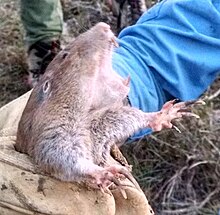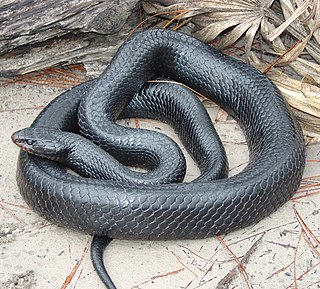
The eastern indigo snake is a species of large, non-venomous snake in the family Colubridae. Native to the southeastern United States, it is the longest native snake species in the country.

Flatwoods, pineywoods, pine savannas and longleaf pine–wiregrass ecosystem are terms that refer to an ecological community in the southeastern coastal plain of North America. Flatwoods are an ecosystem maintained by wildfire or prescribed fire and are dominated by longleaf pine, and slash pine in the tree canopy and saw palmetto, gallberry and other flammable evergreen shrubs in the understory, along with a high diversity of herb species. It was once one of the dominant ecosystem types of southeastern North America. Although grasses and pines are characteristic of this system, the precise composition changes from west to east, that is, from Texas to Florida. In Louisiana, savannas even differ between the east and west side of the Mississippi River. The key factor maintaining this habitat type is recurring fire. Without fire, the habitat is eventually invaded by other species of woody plants.
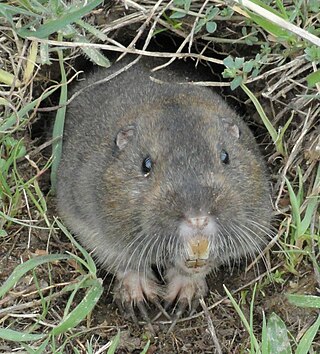
Pocket gophers, commonly referred to simply as gophers, are burrowing rodents of the family Geomyidae. The roughly 41 species are all endemic to North and Central America. They are commonly known for their extensive tunneling activities and their ability to destroy farms and gardens.

The smooth-toothed pocket gophers, genus Thomomys, are so called because they are among the only pocket gophers without grooves on their incisors. They are also called the western pocket gophers because they are distributed in western North America. They are considered distinct enough from other pocket gophers to be recognized as a separate subfamily or tribe.
Goff's southeastern pocket gopher was a pocket gopher endemic to Brevard County, Florida, United States. The last sightings recorded were in 1955. They burrowed and lived mostly underground eating mainly underground vegetation. Their habitat was temperate desert and sandy coastline. Due to human population growth and development of its habitat, this gopher is now extinct.

Botta's pocket gopher is a pocket gopher native to western North America. It is also known in some areas as valley pocket gopher, particularly in California. Both the specific and common names of this species honor Paul-Émile Botta, a naturalist and archaeologist who collected mammals in California in 1827 and 1828.

The hispid cotton rat is a rodent species long thought to occur in parts of South America, Central America, and southern North America. However, recent taxonomic revisions, based on mitochondrial DNA sequence data, have split this widely distributed species into three separate species. The distribution of S. hispidus ranges from Arizona in the west to Virginia to the east and from the Platte River in Nebraska in the north to, likely, the Rio Grande in the south, where it meets the northern edge of the distribution of S. toltecus. Adult size is total length 202–340 mm (8.0–13.4 in); tail 87–122 mm (3.4–4.8 in), frequently broken or stubbed; hind foot 29–35 mm (1.1–1.4 in); ear 16–20 mm (0.63–0.79 in); mass 50–250 g (1.8–8.8 oz). They have been used as laboratory animals.

The Atlantic Plain is one of eight distinct physiographic divisions of the contiguous United States. Using the USGS physiographic classification system, the Atlantic Plain division comprises two provinces and six sections. The Coastal Plain province is differentiated from the Continental Shelf province simply based on the portion of the land mass above and below sea level.

The genus Geomys contains 12 species of pocket gophers often collectively referred to as the eastern pocket gophers. Like all pocket gophers, members of this genus are fossorial herbivores.

The gopher frog is a species of frog in the family Ranidae, endemic to the south-eastern United States. It primarily inhabits the threatened sandhill communities, flatwoods, and scrub in the Atlantic coastal plain, where it is usually found near ponds.

The desert pocket gopher is a species of rodent in the family Geomyidae. It is found in the state of Chihuahua in Mexico and in Texas and New Mexico in the United States.
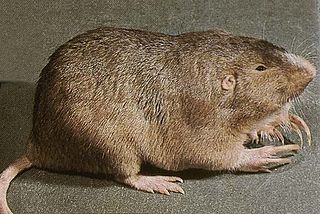
The plains pocket gopher is one of 35 species of pocket gophers, so named in reference to their externally located, fur-lined cheek pouches. They are burrowing animals, found in grasslands and agricultural land across the Great Plains of North America, from Manitoba to Texas. Pocket gophers are the most highly fossorial rodents found in North America.
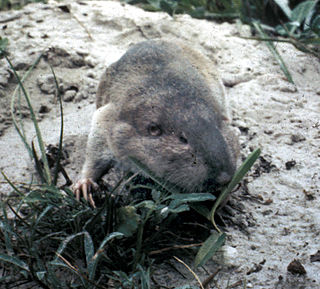
The Texas pocket gopher is a species of rodent in the family Geomyidae. It is found in Tamaulipas in Mexico and in Texas in the United States.

The silky pocket mouse is a species of rodent in the family Heteromyidae. It is found in northern and central Mexico and the southwest region of the United States. It is a species of least concern, according to the IUCN, with no known major threats. The silky pocket mouse eats seeds, succulent parts of plants and nuts, and carries food in its cheek pouches. It lives in low valley bottoms with soft soils, among weeds and shrubs, where it burrows in the sand to bury seed caches. The species is more tolerant of harsh habitat conditions than other pocket mice.

The camas pocket gopher, also known as the camas rat or Willamette Valley gopher, is a rodent, the largest member in the genus Thomomys, of the family Geomyidae. First described in 1829, it is endemic to the Willamette Valley of northwestern Oregon in the United States. The herbivorous gopher forages for vegetable and plant matter, which it collects in large, fur-lined, external cheek pouches. Surplus food is hoarded in an extensive system of tunnels. The dull-brown-to-lead-gray coat changes color and texture over the year. The mammal's characteristically large, protuberant incisors are well adapted for use in tunnel construction, particularly in the hard clay soils of the Willamette Valley. The gophers make chattering sounds with their teeth; males and females make purring sounds when they are together, and the young make twittering sounds. Born toothless, blind and hairless, the young grow rapidly before being weaned at about six weeks of age.

Townsend's pocket gopher is a species of pocket gopher endemic to the northwestern United States.
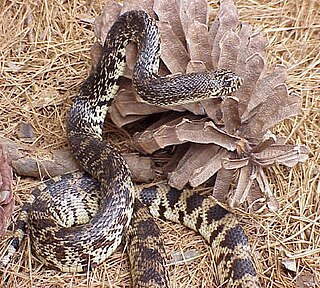
The Louisiana pine snake is a species of large, non-venomous, constrictor in the family Colubridae. This powerful snake is notable because of its large eggs and small clutch sizes. The Louisiana pine snake is indigenous to west-central Louisiana and East Texas, where it relies strongly on Baird's pocket gophers for its burrow system and as a food source. The Louisiana pine snake is rarely seen in the wild, and is considered to be one of the rarest snakes in North America. The demise of the species is due to its low fecundity coupled with the extensive loss of suitable habitat - the longleaf pine savannas in the Gulf coastal plain of the southeastern United States. Management activities are being conducted to promote the species' recovery.

Baird's pocket gopher or the Louisiana pocket gopher is a species of pocket gopher that is native to the southern United States. In total, there are three almost identical species of eastern pocket gopher; Geomys attwateri, G. bursarius, and G. breviceps. G. breviceps is larger in size, G. attwateri is medium-sized and G. bursarius is a bit smaller. Other than by size variation they are not identifiable by external features. Baird's pocket gophers are small rodents with most of their weight on the top half of their bodies.
Knox Jones's pocket gopher is a species of pocket gopher found in Texas and New Mexico. This species is named for Dr. J. Knox Jones Jr. (1929–1992), a prolific mammalogist at Texas Tech University.

The Southeastern conifer forests are a temperate coniferous forest ecoregion of the southeastern United States. It is the largest conifer forest ecoregion east of the Mississippi River. It is also the southernmost instance of temperate coniferous forest within the Nearctic realm.


